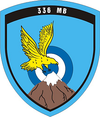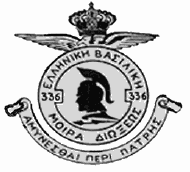336th Bomber Squadron
| 336th Bomber Squadron | |
|---|---|
| 336 Μοίρα Βομβαρδισμού | |
 The badge of 336 Bomber Sq. | |
| Active | 25 February 1943– |
| Country | |
| Branch | Hellenic Air Force |
| Role | Bomber |
| Part of | 116th Combat Wing |
| Garrison/HQ | Araxos Air Base |
| Motto(s) | fly low hit hard |
The336th Bomber Squadron(Greek:336 Μοίρα Βομβαρδισμού,336 MB),callsign"Olympus",is the second oldestsquadronin service with theHellenic Air Force,forming part of the116th Combat Wing.It is based atAraxosAir Base in thePeloponnese,and operates theF-16 Block 52 Advancedaircraft.
History[edit]
Foundation and service in World War II[edit]
After thefall of Greeceto the GermanWehrmacht,theGreek government in exileestablished Greek armed forces to fight alongside the Allies in the Middle East. By 1942, two Greek squadrons, the13th Light Bomber Squadronand the335th Fighter Squadron,were operating under British command. Their good service record and the existence of sufficient numbers of Greek pilots, newly graduated from aviation schools inRhodesia,led to the establishment of a third squadron.
| No. 336 (Greek) Squadron RAF | |
|---|---|
 The emblem of the 336 Squadron in World War II | |
| Active | 25 February 1943 – 31 July 1945 |
| Country | |
| Allegiance | |
| Branch | |
| Role | Fighter squadron |
| Part of | RAF Fighter Command |
| Motto(s) | Αμύνεσθαι περί πάτρης ( "Defend the Fatherland" ) |
| Insignia | |
| Squadron Badge heraldry | No official RAF badge awarded |
The336th Royal Hellenic Pursuit Squadron(336 Βασιλική Ελληνική Μοίρα Διώξεως, 336 Β.Ε.Μ.Δ.), designated within the BritishRoyal Air ForceasNo 336 (Greek) Squadron,was established on 25 February 1943 at LG 219.[1]Equipped with 21HurricaneMk IIc aircraft and under the command ofFlight LieutenantSpyridon Diamantopoulos, it counted many veteran pilots from 335 Squadron in its ranks.[2]This allowed the unit to quickly begin operations: its first combat mission was carried out on 1 March,[3]and the unit was declared operational on 11 April.[4]It was subsequently employed in shipping protection and air defence duties along the Libyan coast, as well as fighter sweeps. The squadron received its first sixSpitfireMk Vc aircraft on 12 October, and over the month of November it participated in several Allied raids againstCrete.Although successful, these missions involved great danger from the German air defence and theLuftwaffe,and resulted in several losses.[3]By March 1944, the unit had been completely re-equipped with Spitfires, and on 15 September, the squadron was moved along with itssister unitto theItalian theatre,from where it carried out operations primarily overoccupied Yugoslavia.[5]
In November the Greek squadrons returned to liberated Greece, where they were engaged in operations from theEllinikon airfieldagainst the remaining German garrisons in the Aegean islands andCrete.[4]In May 1945, the squadron moved to Sedes airfield nearThessaloniki,where, on 31 July 1945, the squadron was disbanded from the RAF and transferred to Greek control.[1]
Post-war history[edit]

Subsequently, 336 Squadron took part in the air operations of theGreek Civil War(1946–49). In February 1949 it was rebased toLarissaunder the110th Combat Wing.In August, the squadron was equipped with theUS-madeCurtiss SB2C Helldiverdive bombers,being redesignated as the336th Light Bomber Squadron(336 Μοίρα Ελαφρού Βομβαρδισμού). In 1953 it was equipped withRepublic F-84 Thunderjetsand redesignated336th Fighter-Bomber Squadron(336 Μοίρα Διώξεως-Βομβαρδισμού).[4]On 28 December 1953, the squadron was transferred to111th Combat WingatNea Anchialos,where it received the newRepublic F-84F Thunderstreakin 1958. Redeployed again to Larissa in March 1959, it was transferred to 116th Combat Wing in December 1962.[4]On 25 September 1963 it was redesignated as a Strike Squadron (Μοίρα Κρούσης) as a reflection of its new role.
On 15 January 1965 the squadron was partially equipped with the newLockheed F-104G Starfighterfighters, and the F-104 section moved to the114th Combat WingatTanagra,while the remainder of the squadron, still equipped with the F-84F, remained at Araxos.[4]In August, the F-84F-equipped section was designated as the 349 Fighter-Bomber Squadron, before being transferred to Larissa in November 1966. In December, the F-104G-equipped 336 Squadron returned from Tanagra to Araxos, where it remains to this day. The squadron would continue to fly the Starfighter until March 1993, following which the squadron was equipped with theVought A-7E Corsair(from a batch of 62 handed over by the US Air Force as surplus following theFirst Gulf War), and established in its present form as the 336 Bomber Squadron on 3 April 1993. Since 2007 it was the last squadron in the world flying the A-7 Corsair II.[4]
The A-7 was finally withdrawn from service on 17 October 2014, and replaced with theF-16 Block 52 Advanced.[4]
References[edit]
Notes[edit]
Bibliography[edit]
- Halley, James J.The Squadrons of the Royal Air Force & Commonwealth 1918–1988.Tonbridge, Kent, UK: Air Britain (Historians) Ltd., 1988.ISBN0-85130-164-9.
- Jefford, C.G.RAF Squadrons, a Comprehensive record of the Movement and Equipment of all RAF Squadrons and their Antecedents since 1912.Shrewsbury, Shropshire, UK: Airlife Publishing, 1988 (second edition 2001).ISBN1-85310-053-6.
- Rawlings, John D.R.Fighter Squadrons of the RAF and their Aircraft.London: Macdonald and Jane's (Publishers) Ltd., 1969 (2nd edition 1976).ISBN0-354-01028-X.
- Οι Μοίρες της Ερήμου ( "The Desert Squadrons" )(PDF)(in Greek). Panhellenic Association of Air Force Veterans. November 2004.
{{cite book}}:|work=ignored (help) - Daloumis, Ilias."Το Hawker Hurricane στην Ελληνική Αεροπορία (" Hawker Hurricane in the Hellenic Air Force ")".Hellenic Wings website(in Greek). Archived fromthe originalon 22 June 2008.Retrieved27 July2008.

